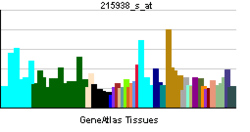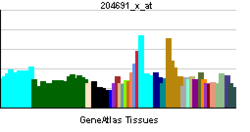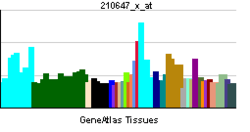PLA2G6
85 kDa calcium-independent phospholipase A2 is an enzyme that in humans is encoded by the PLA2G6 gene.[1][2][3][4]
The protein encoded by this gene is a phospholipase A2 enzyme, a subclass of enzyme that catalyzes the release of fatty acids from phospholipids. The encoded protein may play a role in phospholipid remodelling, arachidonic acid release, leukotriene and prostaglandin synthesis, Fas receptor-mediated apoptosis, and transmembrane ion flux in glucose-stimulated B-cells. Several transcript variants encoding multiple isoforms have been described, but the full-length nature of only two of them have been determined to date.[4]
References
- ↑ Larsson PK, Claesson HE, Kennedy BP (Feb 1998). "Multiple splice variants of the human calcium-independent phospholipase A2 and their effect on enzyme activity". J Biol Chem 273 (1): 207–14. doi:10.1074/jbc.273.1.207. PMID 9417066.
- ↑ Wilson PA, Gardner SD, Lambie NM, Commans SA, Crowther DJ (Aug 2006). "Characterization of the human patatin-like phospholipase family". J Lipid Res 47 (9): 1940–9. doi:10.1194/jlr.M600185-JLR200. PMID 16799181.
- ↑ Kienesberger PC, Oberer M, Lass A, Zechner R (Apr 2009). "Mammalian patatin domain containing proteins: a family with diverse lipolytic activities involved in multiple biological functions". J Lipid Res. 50 Suppl: S63–8. doi:10.1194/jlr.R800082-JLR200. PMC 2674697. PMID 19029121.
- ↑ 4.0 4.1 "Entrez Gene: PLA2G6 phospholipase A2, group VI (cytosolic, calcium-independent)".
Further reading
- Schröder HC, Perovic S, Kavsan V et al. (1998). "Mechanisms of prionSc- and HIV-1 gp120 induced neuronal cell death.". Neurotoxicology 19 (4–5): 683–8. PMID 9745929.
- Leslie CC (2004). "Regulation of arachidonic acid availability for eicosanoid production". Biochem. Cell Biol. 82 (1): 1–17. doi:10.1139/o03-080. PMID 15052324.
- Turk J, Ramanadham S (2005). "The expression and function of a group VIA calcium-independent phospholipase A2 (iPLA2beta) in beta-cells". Can. J. Physiol. Pharmacol. 82 (10): 824–32. doi:10.1139/y04-064. PMID 15573142.
- Law MH, Cotton RG, Berger GE (2006). "The role of phospholipases A2 in schizophrenia". Mol. Psychiatry 11 (6): 547–56. doi:10.1038/sj.mp.4001819. PMID 16585943.
- Tang J, Kriz RW, Wolfman N et al. (1997). "A novel cytosolic calcium-independent phospholipase A2 contains eight ankyrin motifs". J. Biol. Chem. 272 (13): 8567–75. doi:10.1074/jbc.272.13.8567. PMID 9079687.
- Mavoungou E, Georges-Courbot MC, Poaty-Mavoungou V et al. (1997). "HIV and SIV envelope glycoproteins induce phospholipase A2 activation in human and macaque lymphocytes". J. Acquir. Immune Defic. Syndr. Hum. Retrovirol. 16 (1): 1–9. doi:10.1097/00042560-199709010-00001. PMID 9377118.
- Ma Z, Wang X, Nowatzke W et al. (1999). "Human pancreatic islets express mRNA species encoding two distinct catalytically active isoforms of group VI phospholipase A2 (iPLA2) that arise from an exon-skipping mechanism of alternative splicing of the transcript from the iPLA2 gene on chromosome 22q13.1". J. Biol. Chem. 274 (14): 9607–16. doi:10.1074/jbc.274.14.9607. PMID 10092647.
- Larsson Forsell PK, Kennedy BP, Claesson HE (1999). "The human calcium-independent phospholipase A2 gene multiple enzymes with distinct properties from a single gene". Eur. J. Biochem. 262 (2): 575–85. doi:10.1046/j.1432-1327.1999.00418.x. PMID 10336645.
- Dunham I, Shimizu N, Roe BA et al. (1999). "The DNA sequence of human chromosome 22". Nature 402 (6761): 489–95. doi:10.1038/990031. PMID 10591208.
- Kim SJ, Gershov D, Ma X et al. (2002). "I-PLA(2) activation during apoptosis promotes the exposure of membrane lysophosphatidylcholine leading to binding by natural immunoglobulin M antibodies and complement activation". J. Exp. Med. 196 (5): 655–65. doi:10.1084/jem.20020542. PMC 2194002. PMID 12208880.
- Hichami A, Joshi B, Simonin AM, Khan NA (2003). "Role of three isoforms of phospholipase A2 in capacitative calcium influx in human T-cells". Eur. J. Biochem. 269 (22): 5557–63. doi:10.1046/j.1432-1033.2002.03261.x. PMID 12423354.
- Strausberg RL, Feingold EA, Grouse LH et al. (2003). "Generation and initial analysis of more than 15,000 full-length human and mouse cDNA sequences". Proc. Natl. Acad. Sci. U.S.A. 99 (26): 16899–903. doi:10.1073/pnas.242603899. PMC 139241. PMID 12477932.
- Cummings BS, McHowat J, Schnellmann RG (2004). "Role of an endoplasmic reticulum Ca2+-independent phospholipase A2 in cisplatin-induced renal cell apoptosis". J. Pharmacol. Exp. Ther. 308 (3): 921–8. doi:10.1124/jpet.103.060541. PMID 14634037.
- Ota T, Suzuki Y, Nishikawa T et al. (2004). "Complete sequencing and characterization of 21,243 full-length human cDNAs". Nat. Genet. 36 (1): 40–5. doi:10.1038/ng1285. PMID 14702039.
- Bao S, Jin C, Zhang S et al. (2004). "Beta-cell calcium-independent group VIA phospholipase A(2) (iPLA(2)beta): tracking iPLA(2)beta movements in response to stimulation with insulin secretagogues in INS-1 cells". Diabetes. 53 Suppl 1 (90001): S186–9. doi:10.2337/diabetes.53.2007.S186. PMID 14749286.
- Tay HK, Melendez AJ (2004). "Fcgamma RI-triggered generation of arachidonic acid and eicosanoids requires iPLA2 but not cPLA2 in human monocytic cells". J. Biol. Chem. 279 (21): 22505–13. doi:10.1074/jbc.M308788200. PMID 15007079.
- Tanaka H, Minakami R, Kanaya H, Sumimoto H (2004). "Catalytic residues of group VIB calcium-independent phospholipase A2 (iPLA2gamma)". Biochem. Biophys. Res. Commun. 320 (4): 1284–90. doi:10.1016/j.bbrc.2004.05.225. PMID 15249229.


